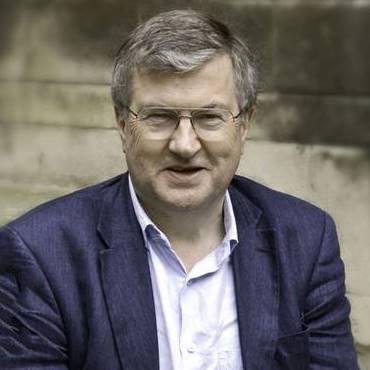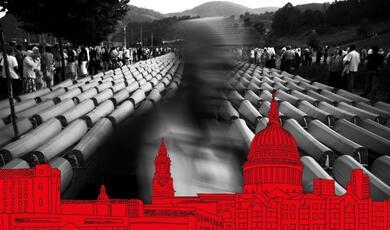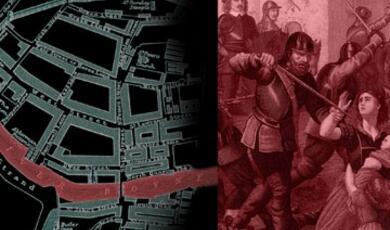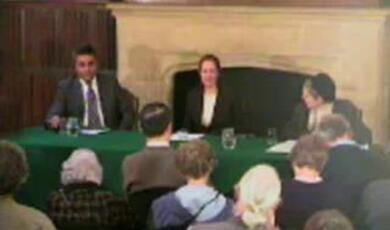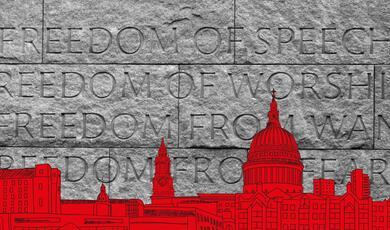Antisemitic Conspiracy Theories: Past, Present and Future?
Share
- Details
- Text
- Audio
- Downloads
- Extra Reading
Antisemitism has existed and continues to exist on many levels, from unthinking prejudice to highly developed theories. Common to all levels is an explicit, or more often, implicit belief that all Jews, usually defined in racial terms, are conspiring secretly to undermine civilisation, order, or social and cultural stability.
This lecture considers the evolution of this conspiracy theory since the Middle Ages, examines its nature and operation today, and considers its future development.
Download Text
Antisemitic Conspiracy Theories: Past, Present and Future?
Professor Sir Richard Evans
22 November 2023
Good evening, everyone. It’s a great privilege to have been invited to deliver this year’s Alfred Wiener Holocaust Memorial Lecture, although when I accepted the invitation to do so, many months ago, I scarcely imagined that I would be speaking in the situation in which we find ourselves today.
On Thursday 2 November staff at the Library discovered that the sign outside its door in Russell Square had been defaced by someone who had sprayed the word ‘Gaza’ on it, as the Director, Dr Toby Simpson, said, in an act ‘obviously intended to cause damage and distress. “To use ignorance as a weapon against an institution of learning’, he continued, ‘is stupid and wrong. To lash out against Israel by targeting a Holocaust institution is an action that can only make sense to antisemites and their enablers.’
This isn’t the first time an act of this kind has targeted the Library. Five years ago, in 2018, a poster at Russell Square tube station advertising an exhibition at the Wiener Holocaust Library on the nationwide Nazi pogrom of 9-10 November 1938 in Germany popularly known as the Reichskristallnacht, or Night of Broken Glass, from the glass shards that littered the streets of Germany’s towns and cities after the windows of some seven and a half thousand Jewish-owned shops had been smashed by Nazi stormtroopers, was defaced with the words ‘Free Palestine’. But since 2018 and above all since the current crisis in the Middle East, the number and intensity of such incidents has multiplied many times over. As Dr Simpson has said: ‘The proliferation of antisemitic hate in the current climate should be a matter of grave concern to us all.’
Between the first and the eighteenth of October this year, the number of antisemitic hate crimes officially recorded in London amounted to 218, a dramatic increase from the 15, one-five, reported over the same period last year. From Saturday 7 October to Tuesday 31 October, the Community Security Trust, a British Jewish organization that plays a leading role in protecting vulnerable sites and monitoring hate crime, recorded 893 antisemitic incidents across the UK, the highest ever total recorded across a twenty-five-day period since the Trust began its reporting in 1984. The incidents included physical assaults and damage to property as well as verbal abuse in person and online.
The Wiener Holocaust Library is the world’s oldest research institution dedicated to the history of the mass murder of some six million Jewish people in Europe by the Nazis and their allies in the 1930s and the first half of the 1940s. It was founded in 1933 by Dr Alfred Wiener, who in the years before the Nazis came to power in Germany worked for the Central Association of German Citizens of Jewish Faith, amassing a huge collection of antisemitic propaganda produced by the Nazis, including newspapers, posters, letters, memoirs, school textbooks, magazines, and other materials, which he eventually brought to London in 1938. The Library has continued to enlarge its collection over the years, and the Director has now added the damaged sign to it, which is of course where it belongs.
When I agreed to deliver this lecture many months ago, I chose the subject of Antisemitic conspiracy theories, and obviously I will now address this topic in the context of recent events. On 7 October this year, the self-styled Islamic Resistance Movement, HAMAS, founded during the first Palestinian Uprising or Intifada against Israel in 1987 as a branch of the Muslim Brotherhood, and the ruling party in the Gaza strip since 2006, launched a violent attack on Israeli territory, during which some 1,400 people in Israel, including young people attending a music festival just three miles from the border, were massacred; some of them were tortured, including a young German-Israeli female tattoo artist and peace activist who was dragged away, killed, her body stripped and paraded through the streets to cries of ‘God is Great’ from the men who surrounded her. Hamas did not spare children or old people or babies in the massacre. Up to two hundred Israelis and others abducted during the assault are being held as hostages by Hamas at undisclosed locations.
In retaliation, the Israeli government ordered a massive airborne and then ground assault on Gaza, which has caused many more thousands of deaths, and inflicted extreme suffering on the inhabitants of the strip. Deprived of food, water and medical care and subject to continual bombardment, the two million men, women and children who live there are experiencing suffering which has aroused horror and sympathy across the world, accompanied by growing demands from many quarters for a ceasefire, either a pause in hostilities to enable humanitarian relief to be given to the inhabitants of Gaza, or a longer-term end to the armed conflict. Essential supplies, not only medicines and medical equipment but also the basic necessities of life, such as food, water and shelter, are being denied to the civilian population, with devastating effects. Maimed and injured children are forced to go without adequate treatment and are succumbing to their injuries.
What lies behind these terrible events, and why have they led to the rise in antisemitism in Britain and other countries that I began by describing? I want to turn first of all to look more closely at Hamas, and its ideology before I move on to examine the politics of the present government of the state of Israel. Who does Hamas represent and what is its relationship to the Palestinians? In 1988, shortly after its formation, Hamas issued a Covenant outlining its core aims and beliefs. It’s a document that breathes a spirit of religious fanaticism of the most uncompromising kind. At its core is a racist, indeed genocidal conspiracy theory directed against Jews across the world. Hamas believes, as Articles 22 and 32 of the Covenant declare, that Jews
were behind the French Revolution, the Communist revolution and most of the revolutions we heard and hear about, here and there…. With their money they were able to control imperialistic countries and instigate them to colonize many countries in order to enable them to exploit their resources and spread corruption there…. They were behind World War I, when they were able to destroy the Islamic Caliphate, making financial gains and controlling resources. They obtained the Balfour Declaration, formed the League of Nations through which they could rule the world. They were behind World War II, through which they made huge financial gains by trading in armaments and paved the way for the establishment of their state. It was they who instigated the replacement of the League of Nations with the United Nations and the Security Council to enable them to rule the world through them. There is no war going on anywhere, without having their finger in it. Today it is Palestine, tomorrow it will be one country or another. The Zionist plan is limitless. After Palestine, the Zionists aspire to expand from the Nile to the Euphrates. When they will have digested the region they overtook, they will aspire to further expansion, and so on. Their plan is embodied in the "Protocols of the Elders of Zion", and their present conduct is the best proof of what we are saying.
Hamas has never repudiated this Covenant, although in 2017 it issued what was in effect a new Covenant, described as supplemental, which made no mention of the Protocols, focused far more exclusively on the liberation of Palestine from Israel, toned down the religious element, dropped the most obvious elements of antisemitism, and committed itself in principle to ideals such as freedom and democracy. It still proclaimed the need for armed struggle and the aim of the destruction of Israel. As a senior Hamas official, Ghazi Hamad, recently told a Lebanese television reporter, 7 October was ‘just the first time, and there will be a second, a third, a fourth’. Asked if Hamas was bent on Israel’s annihilation, he replied ‘yes, of course’.
In practice, the aim of the struggle is not the liberation of Palestine or the defence of the people of Gaza: indeed, one Hamas official, asked by a television reporter if the organisation’s more than 300-mile network of underground tunnels in Gaza could be used to shelter civilians from Israeli bombing raids, explained that this was not going to happen: ‘The tunnels are for us [Hamas]. The citizens in the Gaza Strip’, he said, ‘are under the responsibility of the United Nations’. Despite the 2017 additions to the Covenant, it is a naïve illusion to think that it has anything to do with democracy, humanitarianism, or Palestinian rights. It is true that Hamas won elections in Gaza early in 2006, but opinion polls indicated that this was above all because voters thought that Hamas would bring the rampant corruption of the Fatah government in Palestine to an end; other polls carried out in Gaza at the same time showed strong support for an agreement with Israel. But in the summer of 2007, Hamas carried out a violent coup in Gaza, killing Fatah officials and closing down the institutions of democracy. Since then, the jihadists of Hamas have brooked neither opposition nor dissent, exercising a rigid, Islamist extremist dictatorship over its inhabitants, which includes the end of elections, the banning of same-sex relationships and the repression of women.
It is notable that in its original and still valid Covenant, Hamas refers to the Protocols of the Elders of Zion. What is this document and why is it so widely cited by antisemitic conspiracy theorists? The Protocols are a short tract published in Tsarist Russia in 1903, that purports to be the minutes (or ‘protocols’) of a secret meeting held by Jewish elders on the sidelines of the First Zionist Congress held in Basel, Switzerland, in 1897. Consisting of twenty-four short paragraphs, it presents an account, written in the first-person plural, of how the Jews are subverting civilization by creating economic chaos and undermining the political order through movements such as socialism and anarchism. Everywhere they cause revolutions and upheavals. They control the world’s media, dulling people’s minds to the threat they pose. Once they achieve supreme power, they will make Judaism the only permitted religion. All Jews, all over the world, are controlled by the ‘Elders’ whose strategy for world domination they slavishly follow.
The Protocols are of course an obvious forgery, which was exposed in 1921 by the London Times, in a series of articles showing they were plagiarized from a mid-nineteenth-century French satire, with added elements copied from a Gothic novel written by an ultra-reactionary German police agent and forger around the same time, in the wake of the failed 1848 Revolutions. After the Bolshevik Revolution of 1917 it was taken up by Russian reactionaries, who brought it to the West, where it was translated into other languages and became well known in far-right circles. The young extremists who in 1922 assassinated the German Foreign Minister, Walther Rathenau, a Jewish liberal, claimed to have committed their crime under its influence.
The Protocols are cited by Hamas for a number of reasons. First and foremost, they claim to be proof of a world Jewish conspiracy that comes from the Jews themselves, condemned, as it were, out of their own mouth. Of course, this is nonsense: The 1897 Zionist Congress was a small, obscure affair, held at a time when Zionism, the movement to encourage Jews to settle in Palestine, was a tiny organization unknown even to the great majority of Jews themselves. The idea that it represented all Jews, worldwide, was no more than a fantasy; it had (and has) no foundation in reality. Secondly, however, the Protocols are not framed in the traditional language of Christian antisemitism: there is no mention of the supposed guilt of the Jews for the death of Christ, or the Christian myth of the ‘blood libel’, according to which Jews kidnapped and murdered Christian boys in order to drink their blood, or the accusation, common since the Middle Ages, that Jews engaged in the ritual desecration of the Host, the wafer and wine used at Holy Communion to carry the body and blood of Christ.
The influence of the Protocols can be seen in some aspects of the 1988 Hamas Covenant, such as its mention of Freemasons and, rather oddly, Rotary Clubs as part of the world Jewish conspiracy. At core, what matters is the idea that all Jews, all over the world, are acting in concert, behind the scenes, to achieve global domination. It was an idea central to the ideology of Nazism, shown very clearly in the conspiracy theory that lay behind the Holocaust, according to which the global community of Jews was the instigator of every action taken by Germany’s enemies, and therefore had to be entirely exterminated.
For the Nazis, this was essentially a product of racial instinct. Already in the mid-1920s, in his autobiographical tract and manifesto, Mein Kampf, Hitler expressed his belief that whatever their provenance, the Protocols expressed an essential truth, showing ‘consciously’ what Jews did ‘unconsciously’. Writing in his diary on 13 May 1943, Nazi Propaganda Minister Joseph Goebbels agreed. He was always being told by his staff, he reported, that the Protocols were not suitable to be used in propaganda. But this wasn’t the case. ‘Even if the Zionist Protocols are not genuine’, he wrote, ‘they were none the less invented by a brilliant critic of the age.’ ‘At midday’, he went on, ‘I touch on the subject in conversation with the Führer’:
The Führer takes the view that the Zionist Protocols can make a claim to be absolutely genuine. Nobody can describe the Jewish drive to world domination as the Jews themselves feel it. The Führer takes the view that the Jews don’t need at all to work to a fixed programme; they work according to their racial instinct, which will always prompt them to undertake the kind of action shown in the course of their entire history.
The key aspect of the Protocols was for the Nazis and others who cited them was not what they contained, but the fact that they exposed an essential truth about the Jews in the words of the Jews themselves, that, supposedly, all Jews everywhere acted in concert to implement a secret set of aims for world domination.
Opinion within the leadership of Hamas about the relevance of the 1988 Covenant has for some years been divided, with some taking the view that it is an historic document much of which no longer applies, and others seeing it as a continued declaration of enduring fundamental principles. But the 2017 additions, reasonable as many of them seem, are belied by the events of 7 October, where the distinction they drew between Jews and Zionists, were ignored by the men who carried out the indiscriminate massacres of men, women, children, and babies, which were clearly driven above all by racial and religious hatred.
The influence of conspiracy theory in a milder form is evident in a much more widespread belief, that Israel and its Jewish population are part of a global Jewish community that orchestrates support for whatever the Israeli government does. This can be recognized in claims that there is a ‘Jewish lobby’ in the USA, for example, an assertion that echoes the 1988 Hamas Covenant, and further back, the Nazi Party, in its belief that the press and the media are controlled by Jews; manifestly untrue in the case of Germany in the early 1930s, where the non-Jewish press mogul Alfred Hugenberg was one of the most powerful media magnates of the day. Dominique Vidal, writing on the antisemitism of the French far right, now somewhat toned down under the impact of recent events, has described the concept of an all-powerful ‘Jewish lobby’ as "a phrase that combines standard antisemitic fantasies about Jewish finance, media control and power; the term is the contemporary equivalent of The Protocols of the Elders of Zion’”.
The absence of religious elements in the Protocols pointed to a major change that had come about in the nature of antisemitism in the late nineteenth century. Up to that point, hostility to Jews had been a matter of religion; if an adherent of Judaism converted to Christianity, then in theory at least they would no longer be subjected to discrimination by the Christian majority in in the country where they lived. During the Middle Ages and for a long time afterwards, Jews, a tiny religious minority in Europe, had been subject to numerous restrictions on where they were allowed to live and what they were allowed to do. This made them vulnerable to scapegoating in times of crisis, pushed by conspiracy theories that blamed them, for example, for the massive and poorly understood mass deaths caused by the Black Death in 1348-49, they were accused of poisoning drinking water and subjected to massive popular violence, above all in the Rhineland. But the emergence of racial theory, drawing on ideas first put forward by the evolutionist Charles Darwin, the French racist Arthur de Gobineau, and other writers shifted the focus away from religion and towards heredity, as we can see from the version of antisemitism espoused by Hitler and Goebbels. What religion Jews followed was immaterial and irrelevant – indeed, in some ways they were more dangerous if they abandoned Judaism for Christianity because it made them more difficult to identify; what mattered was who they were descended from, what mattered were what their supposed racial characteristics were.
Of course, this was absurd in more ways than one: Nazi cartoonists showed Jews as hook-nosed, dark-haired and overweight, yet the Third Reich forced them from 1941 onwards to identify themselves with a yellow star in order to make it clear that they were Jewish. Nor could the Nazis ever work out definitively what to do with people who were half-Jewish or a quarter-Jewish: was their Jewish blood so potent that it overwhelmed their ‘Aryan’ blood, or was it the other way round? And when it came to filling in the certificate of racial identity forced on all Germans under Nazi rule, the only way you could show whether or not you were to any degree Jewish was by using the official census, which before 1939 defined Jewishness by religion and not race.
During the nineteenth century, liberal reforms extended civil rights to the previously disadvantaged Jewish religious minority. But this led to a counter-reaction by extreme conservatives, of which the Protocols were an example. A further shift took place with the dissolution of Europe’s global empires and the emergence of postcolonial ideology directed above all at righting the wrong done by Empire and by the continuation of European and American imperialism in other forms. One of the most notable of the 2017 updates to the Hamas Covenant refers to Israel as the product of a ‘racist, anti-human and colonial Zionist project’. This has proved persuasive to many on the Left. But is it racist or colonial? As the historian Simon Sebag Montefiore has recently pointed out:
At the heart of decolonization ideology is the categorization of all Israelis, historic and present, as “colonists.” This is simply wrong. Most Israelis are descended from people who migrated to the Holy Land from 1881 to 1949. They were not completely new to the region. The Jewish people ruled Judean kingdoms and prayed in the Jerusalem Temple for a thousand years, then were ever present there in smaller numbers for the next 2,000 years. In other words, Jews are indigenous in the Holy Land, and if one believes in the return of exiled people to their homeland, then the return of the Jews is exactly that. Even those who deny this history or regard it as irrelevant to modern times must acknowledge that Israel is now the home and only home of 9 million Israelis who have lived there for four, five, six generations… Yet Israeli families resident in Israel for a century are designated as “settler-colonists” ripe for murder and mutilation. And contrary to Hamas apologists, the ethnicity of perpetrators or victims never justifies atrocities. They would be atrocious anywhere, committed by anyone with any history.
He might also have added that after the extermination of six million Jews by the Nazis and their allies, on the sole grounds of their ethnicity, Israel became a refuge for Jewish people fleeing persecution in many parts of the world, from Russia to Ethiopia.
Given this history, the State of Israel surely has the right to defend itself, and the right to exist. Yet historically this has cost others dearly. Some 700,000 non-Jewish Palestinians lost their homes in the course of the State of Israel’s creation out of the British mandate of Palestine, in what Palestinians call the Nakba or catastrophe: more than 500 Palestinian villages were destroyed or depopulated by Zionist militias in the late 1940s, with their former inhabitants denied the right of return; many of them fled to the Gaza Strip, where their descendants still live. But as neighbouring Arab states waged war on the nascent State of Israel, over a quarter of a million Jews fled their territory or were expelled from it, while many more left other Islamic countries and took up residence in Israel. Conflict has continued, above all in the war of 1967, as Israel defeated an attempt to destroy it by neighbouring Arab countries, mainly Egypt, Syria, and Jordan, and again in 1973, in the so-called Yom Kippur War. Since then, a peace process has brought about a cessation of hostilities, although the original postwar United Nations plan for a two-state solution, with independent Israeli and Palestinian states living side by side and Jerusalem being granted international status, has largely faded from the agenda. It’s still surely, in the longer term, the only viable proposal for settling the conflict. In the 1990s for a time, it looked like a real possibility. But there are now massive obstacles in the way.
The Palestinian Authority, created in 1994 as part of the peace process, has turned out to be both corrupt and divided. Run by the Palestinian Liberation organization, Fatah, it is heavily factionalized and since 2007 has lost its role in Gaza, only controlling the West Bank of the River Jordan. If a two-state solution were to be adopted, this would be the basis for the Palestinian state. Currently the Palestinian Authority only controls 39 per cent of the territory of the West Bank, with the rest being under Israeli military occupation since the 1967 war. This is regarded as illegal by the international community but has been subjected to the creation of a growing number of illegal Jewish settlements established in both urban and rural areas. Since October 7, settlers have increased their aggression against the Palestinian and Bedouin inhabitants of the area, well over a hundred and twenty of whom have been killed by armed settlers.
The current Israeli government has done nothing to stop the settler movement or bring to justice the people who have murdered innocent Palestinian civilians. Indeed, it is doing everything it can to prevent a two-state solution. Prime Minister Netanyahu is on record as saying at a meeting of his own Likud Party in 2019 that [and I quote] ‘Anyone who wants to thwart the establishment of a Palestinian state has to support bolstering Hamas and transferring money to Hamas … This is part of our strategy.’ Netanyahu’s cabinet includes extremists such as Bezalel Smotrich, currently Minister of Finance, who has declared that ‘there is no such thing as a Palestinian people’, displayed maps of Israel that include Jordan and parts of Syria and Lebanon, advocated shooting Palestinian demonstrators, and tweeted that Jewish and Palestinian women should be segregated on hospital wards. ‘Anyone who wants to protect the Jewish People and opposes mixed marriages’, he said in 2015, ‘is not a racist. Whoever wants to let Jews live a Jewish life without non-Jews is not a racist.’
Smotrich’s ‘Decisive Plan’ of 2017 envisaged [I quote] ‘Flood(ing), simply so, the areas of Judea and Samaria with settlements and Jewish settlers. When this happens, the Palestinians are supposed to understand that they have no chance to get a state of their own, and they would have to choose between one of the three options – a life of subjugation under Israeli rule, emigration, or a martyr’s death’. It’s important to remember in this context that some 25 per cent of Israeli citizens are Arab, not Jewish, with democratic rights that Smotrich and his fellow extremists would like to see removed. More generally, indeed, the Netanyahu government, in which, the Times of Israel has observed, the extremists are increasingly setting the tone, has been dismantling key pillars of democracy such as the independence of the judiciary arousing widespread and furious protests in Israel. Underlying all this is a claim that the Jewish people have been granted by God exclusive control over a Greater Israel in which Palestinians have no tight to live.
But these extremists are not widely supported, and indeed opposition within Israel to Netanyahu is widespread and determined. His government’s failure to warn about and prevent the Hamas atrocities of October 7 has not been forgiven. Many Israelis are deeply uneasy about the policy of eliminating Hamas by destroying Gaza, in a military action that is being carried out indiscriminately, and without a plausible exit strategy, and is causing untold, horrific human suffering as well as arousing global condemnation. It is important to emphasise that just as Hamas and the Palestinians are not the same, the Netanyahu government and the Israelis are not the same either, let alone representing Jews elsewhere. In the end, the two-state solution is the only conceivable way forward to a long-term peace; plans involving land swaps to make it more viable have been in place for some time.
At the moment, the extremists are in charge. But at some point, they have to find their way to compromise. The idea that Hamas can be eliminated purely by military means is completely unrealistic and leads to terrible atrocities against civilians. The Israeli Defence Force may bomb hospitals in Gaza because Hamas has built tunnels underneath them for military purposes, but all this does is to create yet more bitterness and extremism for the future. Hamas may slaughter Israeli civilians because they think this is the way towards the destruction of the State of Israel and its replacement by an Islamist theocracy, but the effect of this policy is the same, and only makes Israel all the more determined to defend itself. Wars end either when one side achieves victory, as in Europe and East Asia 1945, or when both sides realise they are not going to win, as in Northern Ireland in 1998, but there is no sign that this is going to happen in Gaza any time soon.
There are widespread and growing demands for a ceasefire in Gaza, but the conditions for this at the present are nowhere near being fulfilled. First of all, there is no sign of remaining hostages taken by Hamas on 7th October being released. Second, Hamas has shown no willingness to stop firing rockets into Israel or abandoning its other military actions; indeed, it’s clear that without these commitments, it would use a pause in the conflict to regroup and rearm. Thirdly, the Netanyahu government in Israel has consistently rejected request for a ceasefire because it apparently believes it can achieve the total elimination of Hamas and does not care at the human cost this already involves. Both sides have been and are committing war crimes against civilians, and time will surely allow a better accounting of these crimes in terms of their nature and severity, likelihood of either side being held to account for them by the international community is vanishingly small.
So, at the moment, I don’t see any way for the current conflict to end soon. One modest step would be for the supporters and sympathizers of both sides to tone down their rhetoric and stop flinging around accusations of Nazism. Some Israeli politicians accuse Hamas in particular of behaving like Nazis, though the prime motivation of Hamas is religious and that of the real Nazis was not. Others have claimed that in contrast to Hamas on 7 October the actual perpetrators of the Holocaust during World War II killed Jews reluctantly, though in fact they did so with glee, as you can see from the compilation of their testimonies in the book edited in 1993 by Ernst Klee and other, entitled Those Were the Days: The Holocaust Through the Eyes of the Perpetrators and Bystanders. Hamas routinely refers to Zionists as Nazis, an equation made by the more extreme of its sympathizers, as in this banner carried during the recent pro-Palestinian demonstration in London. Language has its own effect in fuelling extremism, as was made clear by the recent Home Secretary Suella Braverman in labelling November 11’s peace march a ‘hate march’, which called forth the real hate marchers in the form of the violent counter-protestors of the far right.
It would help if politicians and parts of the news media could avoid inflaming the situation. Conspiracy theories in particular are a powerful element in driving extremism not only in the Middle East but in other parts of the world too. One of the most influential is the so-called Great Replacement Theory, which posits a hidden conspiracy to replace the Jewish population of Israel with Arabs and Muslims, who are deliberately having more children in order in the long run to take over the State of Israel; or alternatively, that there is a hidden plot to replace the white majority in the USA with Blacks and Hispanics and, yes, Jews. Far-right conspiracists who allege that there is a plot to force sharia law on European countries, turning Europe into ‘Eurabia’ have spread across the Internet. Anti-immigrant sentiment in the UK, as in other European countries, all too easily spills over into Islamophobia, and there has been a sevenfold increase in Islamophobic incidents in this country since October 7th, including hate crimes and incidents of physical as well as verbal abuse. Even more bizarre conspiracy theories have emerged, including for example the idea that the atrocities committed by Hamas on 7 October were a ‘false flag’ operation conducted by the Israeli security forces to provide a pretext for the bombing and invasion of Gaza.
And one of the most widespread conspiracy theories involves the self-styled fantasy of ‘QAnon’, which puts forward the idea that an anonymous figure, ‘Q’, usually identified with Donald Trump, is leading a crusade against Hillary Clinton and various Hollywood media stars who are kidnapping young boys and draining their blood for medical and other purposes. This is of course a modern version of the medieval ‘blood libel’, in which Jews were accused, often with fatal results, of committing the same crimes, for supposedly ritual and religious purposes. A central figure in such fantasies has been the billionaire George Soros, who has used his fortune to support liberal causes, and it’s no coincidence that he is Jewish by origin. Such anti-Semitic conspiracies spread with unprecedented rapidity across the Internet, the removal of content monitoring on some social media outlets, notably Twitter or ‘X’, as well as Telegram, had made it easier for such fantasies to gain traction. Policing them more effectively is surely necessary if we are to stop the degradation of political discourse and curb the dissemination of harmful and hate-filled conspiracy theories.
As I write, a short-term truce has been negotiated through Qatar between Hamas and the Israeli government to allow humanitarian intervention on a meaningful scale. Perhaps this will be the starting point for a more lasting ceasefire. Of course, many obstacles lie ahead. But we must surely hope that they can be overcome.
© Professor Sir Richard Evans 2023
This event was on Wed, 22 Nov 2023
Support Gresham
Gresham College has offered an outstanding education to the public free of charge for over 400 years. Today, Gresham College plays an important role in fostering a love of learning and a greater understanding of ourselves and the world around us. Your donation will help to widen our reach and to broaden our audience, allowing more people to benefit from a high-quality education from some of the brightest minds.


 Login
Login
